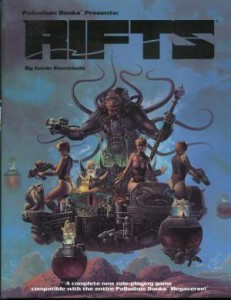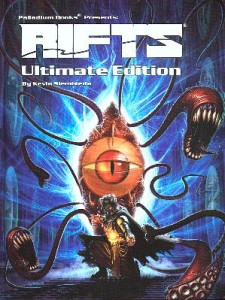
Rifts: A Post-Apocalyptic Experience
PROLOGUE
Nuclear war, EMPs, alien invasion, cannibalistic zombies, Planet X, Hell on Earth, and Jesus Christ Strikes Back! All of these scenarios have one thing in common, The Apocalypse. Nevertheless, some of these scenarios are less likely to happen than others. Thank goodness! Be that as it may, I and probably many of you have fantasized about living in an apocalyptic or post-apocalyptic situation. And there is probably no safer and entertaining way to fantasize about Armageddon than through a roleplaying game. Thus, throughout the years, there have been several roleplaying games based on apocalyptic or post-apocalyptic scenarios. However, there have been none that impress me as much as Rifts by Palladium Books.
In Rifts, all of the above scenarios happened–well all except the one where Jesus goes all Rambo. But with some creative game-mastering even that awesomeness is possible.
GOOD OLD DAYS
In the fall of 1990, my sophomore year in high school, I picked up my first copy of Rifts from my local game shop. It was a small shop that also sold party supplies and was run by a guy who looked like a five-foot gnome–he was quite the character, as you can imagine. I walked a good four or five miles with my friend Kachong to pick the book up. And there it was, the book was sitting there on a store shelf calling me. Its cover art was glorious. It depicted half-naked elven women on a hover vehicle with an ugly humanoid monster that had tentacles coming from his back. It was reminiscent of a Heavy Metal magazine cover and H.P. Lovecraft imagery. Yeah, that cover added to its marketability to most adolescent gamers of the time. But, Rifts was and is more than just a naughty cover.

Rifts was a reflection of the times it was born in. The game came out a year after the fall of the Berlin Wall and over a year before the fall of the Soviet Union. A nuclear doomsday was still on many people’s minds. In entertainment, films and shows, such as Robotech, Gobots (remember them? Yes it did happen.), Transformers, Voltron, and Akira were popular with the kids. Yeah, giant robots and ugly-fleshy-tentacle monsters were the thing back then. But also back in Nerdtopia, fantasy roleplaying games, such as D&D, Palladium, Teenage Mutant Ninja Turtles, Robotech, and anything involving superheroes and science fiction were enjoyed and purchased when possible. These were great times for gamers!
By 1990, Palladium Books had already established itself as a power in the tabletop roleplaying game market. Palladium was already publishing some pretty cool roleplaying games such as Palladium Fantasy (at the time it was just called Palladium), Beyond the Supernatural, Robotech, Teenage Mutant Ninja Turtles, and Heroes Unlimited (a superhero RPG). One of the cool things about these games was that all of them used the same system. At the time this was a fairly rare occurrence. Kevin Siembieda, the creator of Rifts, saw the potential here and took all of these elements, put them together, and created Rifts, a place where the only limits were in the imagination.
Siembieda’s Rifts takes place a few hundred years after the Apocalypse. The vast loss of lives released a massive amount of psychic energy which caused a reawakening of magic in the world. Dimensional portals (very common in Rifts) known as “rifts” allow dimensional beings (D-Bees) to walk Earth freely. Vampires, werewolves, demons, devils, ungodly beings (capable of mass destruction), human time travelers from alternate universes, and just about anything you can conceive can and do come through these rifts. As you can imagine, it’s an extremely dangerous world. But there is some hope for humans. Advanced technology and magic are both equally prominent in the world of Rifts. Thus humans have access to either or even both.
The Rifts core game book allows for almost thirty different archetypes to choose from. Want to play a character who can pilot mechs or use power armor (PA)? Great! There are several different types of mech/PA pilot concepts and vehicles. But the coolest is probably the Glitter Boy. Glitter Boys are the Dirty Harry of mech/PA characters. However, a Glitter Boy’s “Boom Gun” is seven feet long, just a tad bigger than Harry’s gun. But, maybe you’re interested in playing a psychic type character? Fantastic! There are five distinct types to choose from. Have you ever wanted to play a dragon? Well you can here! Maybe a teenage mutant dog? Done! Okay, but perhaps you want a really crazy challenge and just want to play an ordinary Joe with no special abilities? Choose the Vagabond O.C.C. (I actually had a player choose this option and amazingly he didn’t die). Perhaps you want more options than are in the core book for you. Pick up a copy of Heroes Unlimited to play a superhero or After the Bomb (formerly Teenage Mutant Ninja Turtles RPG) to play a mutant animal. Palladium Books has a plethora of books to choose from.
GAME MECHANICS
The game system (sometimes called the Palladium system or Megaversal system) used in Rifts uses the classic d20 for combat, but is not a d20 System. Gamers familiar with the d20 System would have little trouble understanding the rules. Attribute bonuses, combat skill bonuses, and the d20 roll are added together in order to find a character’s result in a combat action. There are also target numbers used for various Saving Throws such as toxins, magic, and psionic attacks. Some fans refer to the system as D&D 2.5. However, unlike the d20 System, Rifts uses two ten-sided dice (called 2D10) as percentile dice to resolve skill rolls. The system is the same used in virtually all of Palladium Books’ roleplaying games and has not really changed in the past twenty-five years, allowing for the world of Rifts to expand and no books to expire. Palladium gamers know this collection of several worlds as the Megaverse.
CHANGES

As mentioned earlier little has changed in the system over the years, but in August 2005, Palladium Books released Rifts Ultimate Edition. Palladium is careful to point out that this edition is not a new edition but rather an expansion and improvement on the game. Many Palladium gamers often use Rifts Ultimate Edition as a core book for all of Palladium games, out of a desire for a book that has some of the latest ideas and rules in one game book. Although there has been little change in Palladium Books game system, Kevin Siembieda and Pinnacle Entertainment Group announced in April 2015 that the Rifts Earth setting would be expanding the Megaverse into the Savage Worlds rules.
Stay tuned for an interview with Sean Patrick Fannon. the author of the up-and-coming Savage Rifts, later today.
